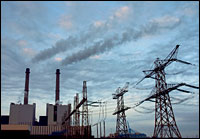Many present-day industrial systems are dramatically overengineered, built to be prepared for maximum demand even though maximum demand is, by definition, rare.
This is easy to see when it comes to the private automobile. Take your average SUV. It has a range of hundreds of miles, the power to navigate hostile offroad territory, seating for seven people, and enough armor to survive direct collision from any angle, yet it spends 90 percent of the time parked and 9 percent ferrying one or two people back and forth to work. It’s a marvel of modern engineering, a monster, a f*cking spaceship, and we use it to get groceries.
An SUV carries around the capacity to do the most extreme things ever asked of it, even if they are under 1 percent of use cases. The same goes for the road and highway system around it, which is built to handle peak traffic even though most roads and most parking spaces are empty most of the time. The whole system is wildly overbuilt.
The electricity system is too, though I’m not sure most people fully understand why. The reason is simply that there’s no storage for electricity. Every electron worth of demand must be met by the simultaneous generation of an electron; similarly, every electron generated must be used immediately or it is lost. That imposes a certain logic on the system: There must always be enough power generation capacity available to handle the maximum possible demand (what’s called “peak load”). The result is that most of our power plants, like most of our cars, spend most of their time parked, idled. They are there for those few minutes of the day when everyone gets home from work and turns on the TV.
This “real-time” nature of the grid is also what makes it vulnerable to blackouts. If power is not continuously fed to an area, the grid shuts down. (Super Bowl viewers were treated to a vivid demonstration of this vulnerability last week.) And sometimes, because most electricity grids are “dumb” and slow to react, the failures can cascade, leading to powerlessness for hundreds of thousands of customers.
Overbuilt and vulnerable is no way to go through life.
Jack Hidary explains this in his latest column and offers a telling comparison to a system that isn’t so vulnerable to disruption:
By contrast, our data grid works in a fault-tolerant manner. When packets are sent over the Internet there are often blockages, slowdowns and other faults. Our information system, though, has hard drives and buffers to store this info temporarily until it can forward the data to the next hop. This is what makes the Internet so robust.
Buffering is one way to increase the resilience of a system and reduce the need for overcapacity. Another is the ability to isolate and route around faults or failures. The internet has both and most electricity systems have neither.
Is such resilience possible for electricity systems? Yes! Electricity storage like batteries and compressed air can offer buffering; smart sensors and controls can offer routing. Both are declining in cost and advancing technologically. Yet utilities have been slow to adopt them. Hidary succinctly explains why:
This is mainly because the oversight system governing the utilities does not provide incentive for upgrades. These costs must be shared directly with the ratepayer and public service commissions have been reluctant to approve such measures.
You see, this is another quirk of the U.S. electricity system: The bodies governing it, state public utility commissions (PUCs), are obliged by law to require that utilities provide power at lowest cost. The lowest-cost option — especially with the limited time horizons and high discount rates used by most PUCs — is generally to keep patching up the current grid. It’s already built and amortized, so utilities just stick new power plants on it every so often. (Deploying capital is how they make money — another incentive to overengineer.)
There is no way build a new power system while also providing lowest-cost electricity from moment to moment. It’s impossible. The legal and regulatory system is practically built to prevent long-term systemic change.
The great evolution of industrial systems in the 21st century will be from muscle to brain, material to intelligence, overbuilding to right-sizing, overcapacity to just-in-time provision. Lighter, smarter, more resilient. As I said the other day, such change cannot be accomplished simply by plucking out widgets from current systems and replacing them with better widgets — electric cars for gas cars, wind farms for coal plants. Entire systems must be redesigned.
We could be doing that with our electrical system. We would be doing it already if we had open, competitive markets for electricity services. Instead we have quasi-public quasi-monopolies practically mandated by law to stick with what they know and nibble around the edges. Until that legal and regulatory system changes, we’ll be stuck with the dumb, overengineered, wasteful system we have today.



